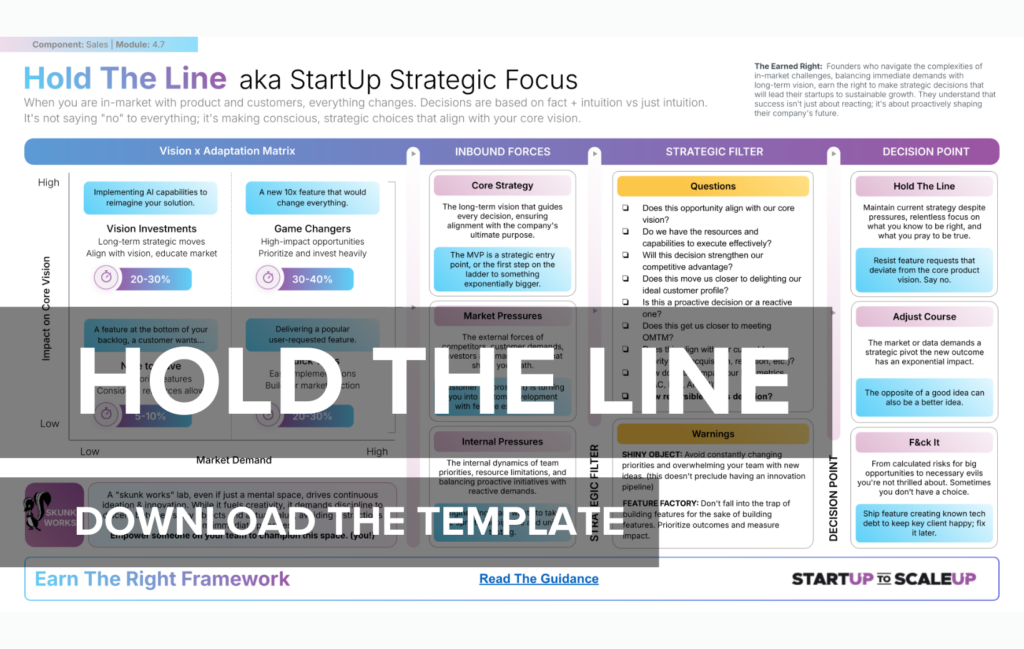How Can Startup Founders Hold the Line Strategically?
Why is maintaining strategic focus challenging for startup founders?
Maintaining strategic focus is challenging for startup founders because they face constant pressure from multiple directions:
- Customer demands: Requests for new features or customizations.
- Market shifts: Rapidly changing competitive landscapes.
- Internal pressures: Team members pushing for their preferred projects.
- Resource constraints: Limited time, money, and personnel.
- Uncertainty: Incomplete information about what will truly drive success.
These pressures can lead founders to react impulsively, chasing every opportunity or customer request. This often results in a loss of focus and can turn the startup into a “feature factory” without a coherent strategy.
How can startup founders balance customer requests with strategic vision?
Balancing customer requests with strategic vision requires:
- Clear prioritization: Use frameworks to evaluate requests against strategic goals.
- Strong communication: Clearly articulate your vision to both customers and team.
- Strategic ‘no’: Learn to say no to requests that don’t align with your core strategy.
- Feedback loops: Gather and analyze customer feedback systematically.
- Flexible roadmap: Maintain a product roadmap that allows for strategic pivots.
Remember, not all customer requests are equally valuable. The goal is to identify and act on feedback that aligns with your long-term vision and has the potential to benefit a significant portion of your user base.
What framework can help startup founders make strategic decisions?
A useful framework for strategic decision-making is the quadrant-based approach:
- Vision Investments: Long-term strategic moves aligned with your core vision.
- Game Changers: High-impact opportunities that could significantly accelerate growth.
- Quick Wins: Easy implementations that provide immediate value.
- Nice to Have: Low-priority features to consider if resources allow.
For each decision, consider:
- Alignment with vision
- Potential impact
- Resource requirements
- Market demand
- Competitive advantage
This framework helps founders categorize and prioritize decisions, ensuring they maintain strategic focus while remaining responsive to market needs.
How can startup founders avoid feature bloat?
Avoiding feature bloat requires discipline and focus:
- Stick to core value proposition: Every feature should directly support your main offering.
- Use data-driven decisions: Prioritize features based on user behavior and feedback.
- Implement feature flags: Test new features with a subset of users before full rollout.
- Regular feature audits: Periodically review and remove underused features.
- Focus on outcomes, not features: Solve customer problems rather than adding bells and whistles.
Remember, a lean, focused product often provides more value than one bloated with rarely-used features. Quality over quantity is key.
What strategies help startup founders maintain focus while remaining adaptable?
Maintaining focus while remaining adaptable involves:
- Clear vision: Have a well-defined long-term goal to guide decisions.
- Regular strategy reviews: Periodically reassess your approach based on new information.
- Experimentation framework: Have a structured way to test new ideas without derailing core focus.
- Flexible planning: Use adaptive planning methods like rolling forecasts.
- Diverse team: Build a team with varied perspectives to challenge assumptions.
The key is to create systems that allow for structured flexibility. This way, you can adapt to changing circumstances without losing sight of your overall goals.
How can startup founders effectively prioritize their product roadmap?
Effective product roadmap prioritization involves:
- Align with strategy: Ensure each item supports your overall business goals.
- Consider impact vs effort: Prioritize high-impact, low-effort items.
- Use customer feedback: Incorporate user needs and pain points.
- Balance short and long-term: Mix quick wins with strategic investments.
- Stay flexible: Be ready to adjust based on market changes or new insights.
Tools like the RICE framework (Reach, Impact, Confidence, Effort) can help quantify and compare different options objectively.
Holding the line strategically is about maintaining a delicate balance. Startup founders must stay true to their vision while remaining responsive to market realities. By using structured decision-making frameworks, prioritizing effectively, and maintaining adaptability, founders can navigate the challenges of growth without losing their strategic focus.
The goal is not to please everyone, but to build a product that delivers significant value to your target market.
